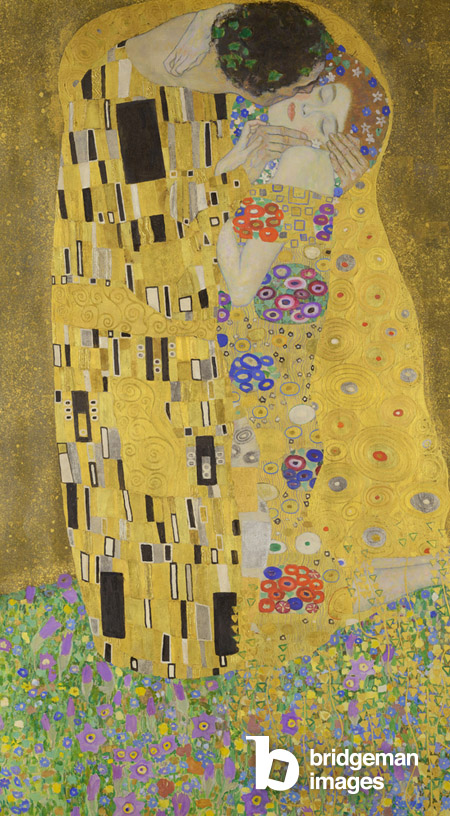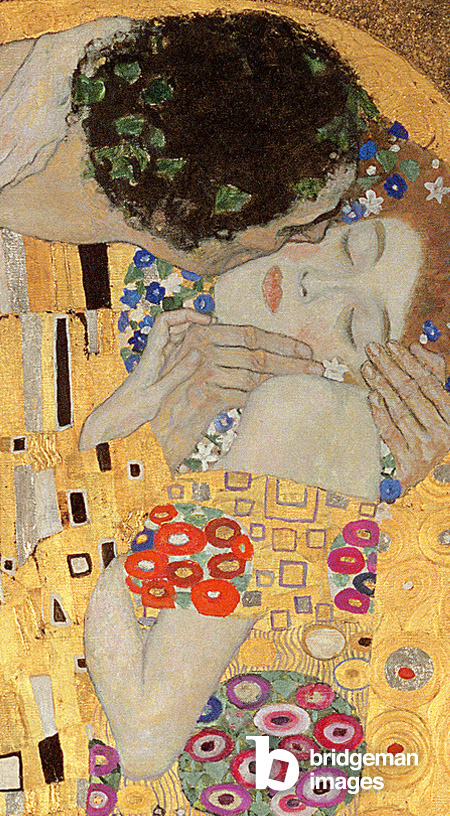Published 20/10/2023
There are few iconic paintings in the world, and Gustav Klimt’s “The Kiss” is one of them. Rising out of the Art Nouveau movement, its intricate patterns and shimmering gold leaf background have inspired viewers for over a century. The painting depicts a couple embraced in a passionate kiss. The man’s face is distorted by the woman’s hair, but her face is turned up and we can see her eyes closed as she’s lost in passion.

Who Painted ‘The Kiss’?
Gustav Klimt, who painted ‘The Kiss’, was an Austrian artist born in 1862. He died in 1918 but is known as the leader of the Art Nouveau movement. His work is renowned for its lavish gold leaf, sensual subject matter, and complex patterns.
Klimt was born in Vienna, Austria, and began his career as a decorative painter, but before long he turned his talents toward allegorical projects and portraits. His early work was heavily influenced by Symbolism, but he slowly forged his unique personal style.
By the early 1900s, Klimt had formed the Vienna Secession, which was a group of rebelling artists fighting against the traditional academic style of painting. The Secessionists were steered by Art Nouveau, which was a new style of art characterised by its long, organic, and sinuous linework.
The “Golden Period” of Klimt’s life is said to be between 1903 and 1909, and it’s when he painted some of his greatest pieces, including Adele Bloch-Bauer I (1907), Judith and the Head of Holofernes (1901), and The Kiss (1907-1908). All of these pieces are a testament to Klimt’s expert use of elaborate patterns and gold leaf.
While Klimt is now recognised as one of the most important artists in the Art Nouveau movement, his work was extremely controversial during his lifetime. In particular, the works he completed for the Great Hall of the University of Vienna were viewed as pornographic.
Where Is the Kiss Painting in Vienna?
To get a glimpse of Klimt’s ‘The Kiss’, head to the Belvedere Museum in Vienna, Austria, where it’s on permanent display. The Belvedere Museum is a fascinating complex of three museums, and ‘The Kiss’ can be found in the Upper Belvedere, which is located in the former Baroque Palace.
The Upper Belvedere is located on the Rennweg, which is a stone’s throw away from the city centre. It can be reached on foot, by public transport, or by taxi. When visiting this incredible museum, it’s best to arrive early because it gets incredibly busy.
‘The Kiss’ Painting by Gustav Klimt
The Kiss masterpiece measures around 180x180 centimetres, so there are plenty of intricate details to take in. The painting is oil on canvas and features gold leaf and other unique decorative elements typical of the Art Nouveau movement.
The painting shows a passionate kiss between a man and a woman. The man stands behind the woman, with his arms wrapped around her waist. The woman is leaning back against the man, her head turned up towards his. The couple’s faces are very close and their eyes are closed in ecstasy.
Surrounding the couple is a golden halo, which symbolises the sacredness of their moment and their lasting love. The robes worn by the couple are decorated with knotted patterns and floral motifs, which is a common feature among Art Nouveau and Byzantine works. The swirling pattern in the background creates a sense of energy and movement.
The Kiss is a multi-layered and complex piece of work, and it can be interpreted in many different ways including as a meditation on the human form, a celebration of love, and a reflection on the spiritual nature of art. Here is a closer look at some of the painting’s central elements and what they may represent:
● The couple. The couple is often viewed as representing the ideal romantic love because they’re beautiful, young, and completely lost in each other. The kiss is a symbol representing devotion and passion.
● The intricate patterns. The patterns on the robes are typical of Art Nouveau, which stands for the interconnectedness of all things and the beauty of nature.
● The golden halo. The golden halo is a representation of their timeless love and the sacredness of The Kiss.
● The swirling background. The background is full of energy and movement, which indicates the sheer power of the couple’s love.
The Conservation of ‘The Kiss’ Painting
The Kiss painting is extremely valuable, but it’s also fragile because of the delicate material used and gold leaf detailing. There have been several conservation projects over the last century, with the most recent being in 2012. This process involves repairing any damage, cleaning the painting, and applying a protective coat of varnish.
Unlike other works of this stature, The Kiss presents challenges during conservations. For example, the gold leaf is extremely delicate and thin, meaning it can be easily damaged. Additionally, the sheer size and weight of the painting mean it has to be transported with the utmost care to avoid causing unnecessary damage.
Even though the process can be problematic, it’s essential to preserve The Kiss painting for future generations to enjoy. Here are some more specific steps involved in the process:
- The Kiss is carefully removed from the frame and placed on a specially crafted table.
- The painting is dusted, vacuumed, and cleaned using other techniques.
- Tiny cracks and tears are repaired, and any loose pieces of gold leaf are reattached.
- A protective coat is applied to protect the painting from environmental hazards.
- The painting is returned to its spot in the Belvedere Museum.

The Historical Context of the Kiss Painting
Klimt painted The Kiss between 1907 and 1908, at the height of the Art Nouveau movement, which was a new style of art that emerged during the late 19th century. This stunning style was characterised by decorative elements, organic forms, and the use of new technologies and materials.
Art Nouveau was born out of rebellion against the outdated and rigid academic art style. Artists within the movement were inspired by nature, and they attempted to create functional and beautiful pieces.
Although the Art Nouveau movement was founded by a group of Belgian painters, designers, and sculptures called Les XX (Les Vingts), Klimt was a leading figurehead of the movement in Vienna. He was captivated by decorative features and gold leaf used in Japanese art and Byzantine mosaics. He borrowed these elements and integrated them into his work to create a feeling of opulence and luxury.
The Cultural Impact of ‘The Kiss’ Painting
Since its completion in 1908, The Kiss has had an enormous cultural impact. It’s deemed one of the most iconic and popular paintings in the world, and it’s been referenced and reproduced in countless works of literature, art, and pop culture.
The Kiss inspired the works of Roy Lichtenstein, Andy Warhol, and Frida Kahlo. In literature, The Kiss was mentioned in James Joyce’s Ulysses and Oscar Wilde’s The Picture of Dorian Gray. Elsewhere, the painting has been featured in films like The Godfather and Casablanca, and songs by Prince and The Cure.
Gustav Klimt’s ‘The Kiss’ is the perfect representation of the Art Nouveau movement and a celebration of beauty, love, and the human spirit. Thanks to conservation efforts made by the Belvedere Museum, anyone can go and marvel at this masterpiece.
View our selection of works from the Art Nouveau movement.
Visit Bridgeman Editions to purchase an exclusive print of this piece.


